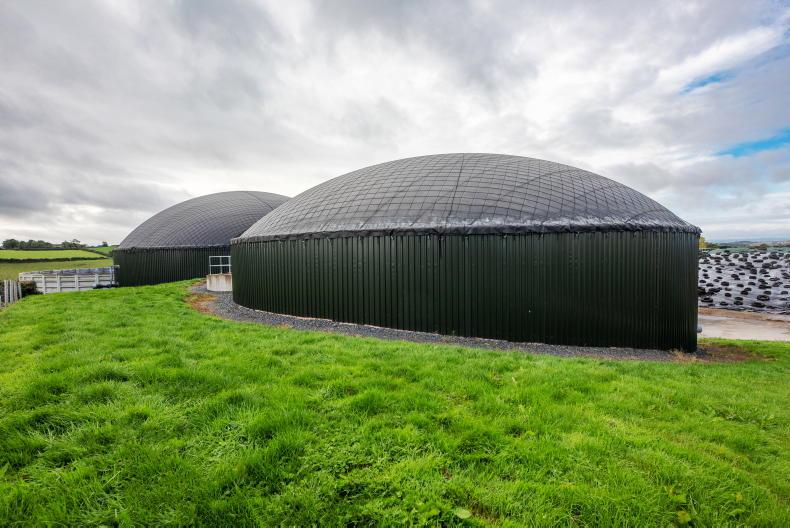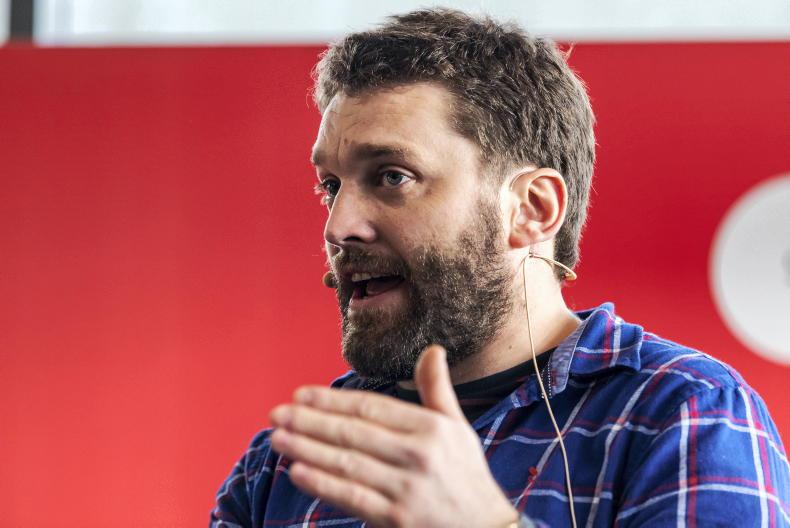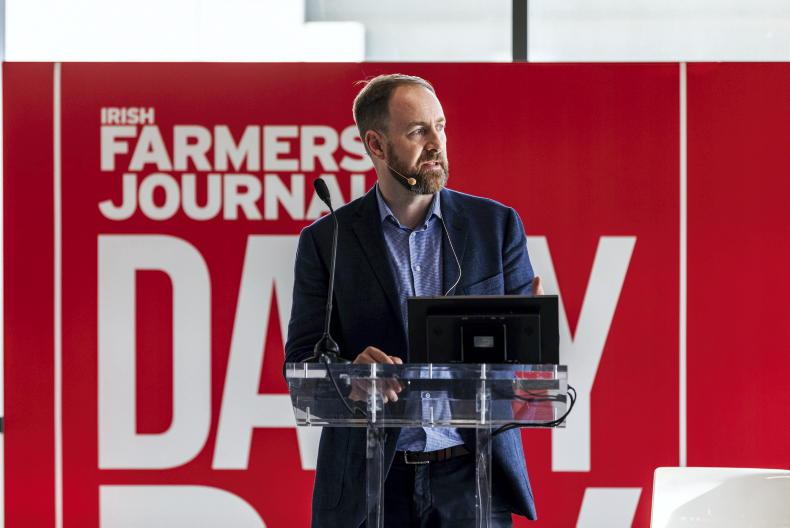The dairy sector stands to gain more than it may lose by engaging with the emerging anaerobic digestion (AD) industry.
However, there is a significant lack of knowledge about how the industry is evolving and how dairy can benefit, both at the farm and industry levels.
These were some of the key takeaways from the ‘AD and Dairying: Friends or Foes?’ talk at this year’s Irish Farmers Journal Dairy Day.
Throughout the talk, and indeed, during discussions with dairy farmers and industry stakeholders throughout the day, some hard truths were discussed.

AD and dairying can be mutually beneficial.
The biggest fear in the dairy industry is increased competition for land from AD. However, if AD is developed in parallel with the dairy sector with input from it, AD can provide solutions to the biggest challenges facing dairy farmers, particularly in nutrient management and sustainability.
Refusing to engage and remaining excluded from the AD industry out of fear of creating competition may, ironically, lead to the AD industry becoming competition for dairy farmers, with little benefit to them. In other words, a self-fulfilling prophecy.
The decision to engage with AD lies with the dairy sector, as the AD industry is already attempting to collaborate with every sector. However, AD doesn’t necessarily require the dairy sector’s participation to develop, especially in the first wave of plants. Therefore, the dairy sector needs to be proactive.
There is nothing stopping dairy farmers from developing the plants themselves, too, or at least laying the groundwork in anticipation of support policies coming down the line, as some dairy farmers already are.
Friends or Foes
Teagasc post-doctoral researcher, Maurice Deasy, and anaerobic digestion plant developer and operator, David McDonnell, gave insight into the practicalities of AD in Ireland and where the industry is heading.

Maurice Deasy.
Maurice explained that the majority of AD plants currently in Ireland are combined heat and power plants, which produce electricity for export to the grid. However, the new AD industry emerging in Ireland will upgrade biogas to biomethane to replace natural gas. Maurice explained that economies of scale matter for biomethane; the minimum viable size of a plant will likely have a minimum feedstock requirement of over 100t/day. These are not small plants, he remarked.
Nutrient distribution hub
Maurice explained that Ireland’s agri AD biomethane industry will largely be based on a grass and slurry model, roughly a 50:50 blend. He stressed that while 80% of the biomethane yield comes from grass silage, slurry will also be an important feedstock to help meet greenhouse emission reduction targets.
Therefore, an AD plant should really be seen as a nutrient distribution hub, he explained, facilitating the movement of nutrients from where they are overproduced to where they are needed.
On a dairy farm, about 10% of emissions come from the slurry in the tank, so AD can be an important tool in tackling that, as sending slurry to an AD plant captures that gas.
He said farmers who are hesitant about giving away their slurry will get a better fertiliser back in return in the form of digestate. Digestate has a lower carbon-to-nitrogen ratio and is a better fertiliser for grass and crops when compared to slurry.
Maurice stressed, though, that watery slurry doesn’t make biogas.
An AD plant should really be seen as a nutrient distribution hub, facilitating the movement of nutrients from where they are overproduced to where they are needed
He said that AD operators are not going to spend upwards of €20m on a development and risk putting low dry matter slurry or parlour washings with traces of chemicals into the system.
A crucial flaw in policy, however, was highlighted on the day. Irish Farmers Journal dairy specialist, Declan Collins, pointed out that if a dairy farmer exports slurry in derogation, the digestate is currently classified as an organic fertiliser, and it may not be able to be imported back on the farm.
Yet, if it was classified as a “bio-fertiliser”, as is the case in parts of Europe, they could get around this, allowing derogation dairy farmers to export all of their slurry and take back only what they need in digestate.
This is an example of the importance of developing an AD industry in parallel with the dairy sector to ensure maximum benefit for farmers.
Growing grass for AD v dairy
Based on his analysis, Maurice explains that if you look at the profitability of enterprises, you likely won’t make more money growing grass to sell to an AD plant compared to milking cows. So, he doesn’t see AD as a threat to dairy.
However, it will be competitive against cattle and sheep production, so those farmers could stand to make more income from supplying AD projects than rearing animals if they choose to.
David McDonnell from Shanagolden in Limerick gave attendees a practical insight into developing and running an AD plant.
He and his brother run a dairy and poultry farm in Limerick, and in 2010, they, along with their father, built an AD plant to produce 1MW of energy for export. The heat from the plant also helps to heat the poultry sheds.

David McDonnell.
Around half of the feedstock for the AD plant comes from the livestock and poultry enterprises on the farm, while the rest comes from food waste and dairy sludges.
Around 80% of the digestate goes out on their own land, which displaces 20 tonnes of fossil fuel fertilisers each year. In total, his project saves 300 tonnes of CO2 each year.
Key considerations
David said that dairy farmers can play their part in climate action and the circular economy by being involved with or developing an AD project themselves.
But he stressed that AD is not a matter of building tanks, covering them and hoping the gas will come.
Farmers need to appreciate that this isn’t just an automatic bolt-on to dairying; AD is a whole other business you are starting on your farm, he said.
There is a lot to consider and a lot of learning to do before proceeding with a project, or even a planning an application for that matter.
One element David considered in the early stages was how he was going to make the project economically viable.
At the time of planning their project, there was a Government-backed scheme, which, along with accepting a gate fee for waste, made the project bankable.
He said there is a debate at the moment as to whether the Government will provide capital grants or a long-term biomethane support tariff for 15-20 years. His personal view is that the tariff support is the better mechanism, as it will help provide certainty about the price you’re going to get for your end product.
Operation and
maintenance
David built his plant in 2010, using a lot of direct labour for the civil works, which saved a considerable amount of money, but took longer to complete. He said the operation and maintenance considerations of an AD plant are important and are sometimes overlooked.
His plant takes four full-time staff to run and must run 24/7.
AD is a whole other business you are starting on your farm
If something goes wrong, it needs to be sorted regardless of the time. Parts need to be replaced after certain intervals, which can cost thousands.
He said that continuous training is needed and reminded attendees of the health and safety considerations of AD plants, as they are, after all, producing gas.
Inspections and audits are also common, and he acknowledged that planning will be difficult, and you have to be mindful of neighbours in the process.
However, overall, commenting on the plant, he said it has been a good business for them, but told farmers that if they are considering an AD project, then they should enter it with their eyes wide open and do their own diligence.
The author Stephen Robb is currently involved in a family/community proposal for an anaerobic digestion facility in Co Donegal.
The dairy sector stands to gain more than it may lose by engaging with the emerging anaerobic digestion (AD) industry.
However, there is a significant lack of knowledge about how the industry is evolving and how dairy can benefit, both at the farm and industry levels.
These were some of the key takeaways from the ‘AD and Dairying: Friends or Foes?’ talk at this year’s Irish Farmers Journal Dairy Day.
Throughout the talk, and indeed, during discussions with dairy farmers and industry stakeholders throughout the day, some hard truths were discussed.

AD and dairying can be mutually beneficial.
The biggest fear in the dairy industry is increased competition for land from AD. However, if AD is developed in parallel with the dairy sector with input from it, AD can provide solutions to the biggest challenges facing dairy farmers, particularly in nutrient management and sustainability.
Refusing to engage and remaining excluded from the AD industry out of fear of creating competition may, ironically, lead to the AD industry becoming competition for dairy farmers, with little benefit to them. In other words, a self-fulfilling prophecy.
The decision to engage with AD lies with the dairy sector, as the AD industry is already attempting to collaborate with every sector. However, AD doesn’t necessarily require the dairy sector’s participation to develop, especially in the first wave of plants. Therefore, the dairy sector needs to be proactive.
There is nothing stopping dairy farmers from developing the plants themselves, too, or at least laying the groundwork in anticipation of support policies coming down the line, as some dairy farmers already are.
Friends or Foes
Teagasc post-doctoral researcher, Maurice Deasy, and anaerobic digestion plant developer and operator, David McDonnell, gave insight into the practicalities of AD in Ireland and where the industry is heading.

Maurice Deasy.
Maurice explained that the majority of AD plants currently in Ireland are combined heat and power plants, which produce electricity for export to the grid. However, the new AD industry emerging in Ireland will upgrade biogas to biomethane to replace natural gas. Maurice explained that economies of scale matter for biomethane; the minimum viable size of a plant will likely have a minimum feedstock requirement of over 100t/day. These are not small plants, he remarked.
Nutrient distribution hub
Maurice explained that Ireland’s agri AD biomethane industry will largely be based on a grass and slurry model, roughly a 50:50 blend. He stressed that while 80% of the biomethane yield comes from grass silage, slurry will also be an important feedstock to help meet greenhouse emission reduction targets.
Therefore, an AD plant should really be seen as a nutrient distribution hub, he explained, facilitating the movement of nutrients from where they are overproduced to where they are needed.
On a dairy farm, about 10% of emissions come from the slurry in the tank, so AD can be an important tool in tackling that, as sending slurry to an AD plant captures that gas.
He said farmers who are hesitant about giving away their slurry will get a better fertiliser back in return in the form of digestate. Digestate has a lower carbon-to-nitrogen ratio and is a better fertiliser for grass and crops when compared to slurry.
Maurice stressed, though, that watery slurry doesn’t make biogas.
An AD plant should really be seen as a nutrient distribution hub, facilitating the movement of nutrients from where they are overproduced to where they are needed
He said that AD operators are not going to spend upwards of €20m on a development and risk putting low dry matter slurry or parlour washings with traces of chemicals into the system.
A crucial flaw in policy, however, was highlighted on the day. Irish Farmers Journal dairy specialist, Declan Collins, pointed out that if a dairy farmer exports slurry in derogation, the digestate is currently classified as an organic fertiliser, and it may not be able to be imported back on the farm.
Yet, if it was classified as a “bio-fertiliser”, as is the case in parts of Europe, they could get around this, allowing derogation dairy farmers to export all of their slurry and take back only what they need in digestate.
This is an example of the importance of developing an AD industry in parallel with the dairy sector to ensure maximum benefit for farmers.
Growing grass for AD v dairy
Based on his analysis, Maurice explains that if you look at the profitability of enterprises, you likely won’t make more money growing grass to sell to an AD plant compared to milking cows. So, he doesn’t see AD as a threat to dairy.
However, it will be competitive against cattle and sheep production, so those farmers could stand to make more income from supplying AD projects than rearing animals if they choose to.
David McDonnell from Shanagolden in Limerick gave attendees a practical insight into developing and running an AD plant.
He and his brother run a dairy and poultry farm in Limerick, and in 2010, they, along with their father, built an AD plant to produce 1MW of energy for export. The heat from the plant also helps to heat the poultry sheds.

David McDonnell.
Around half of the feedstock for the AD plant comes from the livestock and poultry enterprises on the farm, while the rest comes from food waste and dairy sludges.
Around 80% of the digestate goes out on their own land, which displaces 20 tonnes of fossil fuel fertilisers each year. In total, his project saves 300 tonnes of CO2 each year.
Key considerations
David said that dairy farmers can play their part in climate action and the circular economy by being involved with or developing an AD project themselves.
But he stressed that AD is not a matter of building tanks, covering them and hoping the gas will come.
Farmers need to appreciate that this isn’t just an automatic bolt-on to dairying; AD is a whole other business you are starting on your farm, he said.
There is a lot to consider and a lot of learning to do before proceeding with a project, or even a planning an application for that matter.
One element David considered in the early stages was how he was going to make the project economically viable.
At the time of planning their project, there was a Government-backed scheme, which, along with accepting a gate fee for waste, made the project bankable.
He said there is a debate at the moment as to whether the Government will provide capital grants or a long-term biomethane support tariff for 15-20 years. His personal view is that the tariff support is the better mechanism, as it will help provide certainty about the price you’re going to get for your end product.
Operation and
maintenance
David built his plant in 2010, using a lot of direct labour for the civil works, which saved a considerable amount of money, but took longer to complete. He said the operation and maintenance considerations of an AD plant are important and are sometimes overlooked.
His plant takes four full-time staff to run and must run 24/7.
AD is a whole other business you are starting on your farm
If something goes wrong, it needs to be sorted regardless of the time. Parts need to be replaced after certain intervals, which can cost thousands.
He said that continuous training is needed and reminded attendees of the health and safety considerations of AD plants, as they are, after all, producing gas.
Inspections and audits are also common, and he acknowledged that planning will be difficult, and you have to be mindful of neighbours in the process.
However, overall, commenting on the plant, he said it has been a good business for them, but told farmers that if they are considering an AD project, then they should enter it with their eyes wide open and do their own diligence.
The author Stephen Robb is currently involved in a family/community proposal for an anaerobic digestion facility in Co Donegal.









 This is a subscriber-only article
This is a subscriber-only article










SHARING OPTIONS: